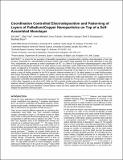Files in this item
Coordination controlled electrodeposition and patterning of layers of palladium/copper nanoparticles on top of a self-assembled monolayer
Item metadata
| dc.contributor.author | She, Zhe | |
| dc.contributor.author | Yao, Zhen | |
| dc.contributor.author | Ménard, Hervé | |
| dc.contributor.author | Tobish, Sven | |
| dc.contributor.author | Lahaye, Dorothée | |
| dc.contributor.author | Champness, Neil R. | |
| dc.contributor.author | Buck, Manfred | |
| dc.date.accessioned | 2020-07-14T23:34:11Z | |
| dc.date.available | 2020-07-14T23:34:11Z | |
| dc.date.issued | 2019-07-15 | |
| dc.identifier | 259650222 | |
| dc.identifier | cdd8698b-a2ac-46fe-955e-642b9130fbd8 | |
| dc.identifier | 000477704400007 | |
| dc.identifier | 85069635765 | |
| dc.identifier.citation | She , Z , Yao , Z , Ménard , H , Tobish , S , Lahaye , D , Champness , N R & Buck , M 2019 , ' Coordination controlled electrodeposition and patterning of layers of palladium/copper nanoparticles on top of a self-assembled monolayer ' , Nanoscale , vol. Advance Article . https://doi.org/10.1039/C9NR03927A | en |
| dc.identifier.issn | 2040-3364 | |
| dc.identifier.other | Bibtex: urn:d5ca97d8f2025cd401000517e0c8ea09 | |
| dc.identifier.other | ORCID: /0000-0003-1225-7607/work/59698693 | |
| dc.identifier.uri | https://hdl.handle.net/10023/20251 | |
| dc.description | Support by EPSRC (EP/E061303/1, EP/D048761/1) and the Chinese Scholarship Council and the University of St Andrews for a stipend (Z. Y.) are gratefully acknowledged. | en |
| dc.description.abstract | A scheme for the generation of bimetallic nanoparticles is presented which combines electrodeposition of one type of metal, coordinated to a self-assembled monolayer (SAM), with another metal deposited from the bulk electrolyte. In this way PdCu nanoparticles are generated by initial complexation of Pd2+ to a SAM of 3-(4-(pyridine-4-yl)phenyl)propane-1-thiol (PyP3) on Au/mica and subsequent reduction in an acidic aqueous CuSO4 electrolyte. Cyclic voltammetry reveals that the onset of Cu deposition is triggered by Pd reduction. Scanning tunneling microscopy (STM) shows that layers of connected particles are formed with an average thickness of less than 3 nm and lateral dimensions of particles in the range of 2 to 5 nm. In X-ray photoelectron spectra a range of binding energies for the Pd 3d signal is observed whereas the Cu 2p signal appears at a single binding energy, even though chemically different Cu species are present: normal and more noble Cu. Up to three components are seen in the N 1s signal, one originating from protonated pyridine moieties, the others reflecting the SAM-metal interaction. It is suggested that the coordination controlled electrodeposition yields layers of particles composed of a Pd core and a Cu shell with a transition region of a PdCu alloy. Deposited on top of the PyP3 SAM, the PdCu particles exhibit weak adhesion which is exploited for patterning by selective removal of particles employing scanning probe techniques. The potential for patterning down to the sub-10 nm scale is demonstrated. Harnessing the deposition contrast between native and PdCu loaded PyP3 SAMs, structures thus created can be developed into patterned continuous layers. | |
| dc.format.extent | 390725 | |
| dc.language.iso | eng | |
| dc.relation.ispartof | Nanoscale | en |
| dc.subject | QD Chemistry | en |
| dc.subject | DAS | en |
| dc.subject.lcc | QD | en |
| dc.title | Coordination controlled electrodeposition and patterning of layers of palladium/copper nanoparticles on top of a self-assembled monolayer | en |
| dc.type | Journal article | en |
| dc.contributor.sponsor | EPSRC | en |
| dc.contributor.sponsor | EPSRC | en |
| dc.contributor.institution | University of St Andrews. School of Chemistry | en |
| dc.contributor.institution | University of St Andrews. EaSTCHEM | en |
| dc.identifier.doi | 10.1039/C9NR03927A | |
| dc.description.status | Peer reviewed | en |
| dc.date.embargoedUntil | 2020-07-15 | |
| dc.identifier.grantnumber | EP/E061303/1 | en |
| dc.identifier.grantnumber | EP/D048761/1 | en |
This item appears in the following Collection(s)
Items in the St Andrews Research Repository are protected by copyright, with all rights reserved, unless otherwise indicated.

